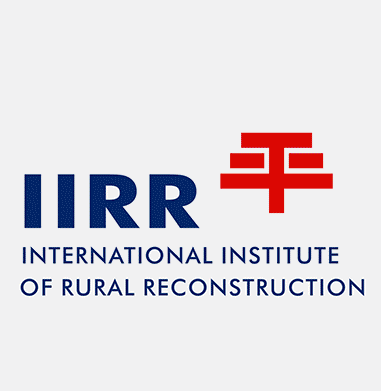We have over 95 years of experience in empowering communities to overcome poverty. Led by our founder Dr. Y.C. James Yen, since early 1920s, our predecessor the Chinese Mass Education Movement was responsible for changing, for better, and the lives of over 200 million Chinese peasants through the power of functional literacy. Since IIRR was formally organized as an international development, training, and research organization in 1960 in the Philippines, we have continued to empower the rural poor to end poverty in Asia, Africa and Latin America.
We use innovative approaches that are integrated, people-centered and sustainable; the process we pioneered since early 20’s when these concepts were little known to development community. This philosophy of development guides all our work; we do not offer handouts. We offer education and capacity building so that community members and their local organizations can enact changes relevant to them. Our core tenet at IIRR is to develop sustainable and effective solutions to poverty reduction by working with and learning from local communities. We believe in “outsiders can help, but insiders must do the job”.
We have strong anti-poverty programs in eight (8) countries in Southeast Asia (Philippines, Cambodia and Myanmar) and Eastern and Southern Africa (Kenya, Ethiopia, Uganda, South Sudan and Zimbabwe). In these countries and regions, we work in collaboration with more than 125 local development partners, and all our 140 staff members are nationals of these countries.
We are a United States-based 501(c) (3) private voluntary organization with a small office in New York City, but we operate our headquarters from the global south, the Philippines. These are the deliberate choices we made to be closer to the people we work with and which make our work relevant and cost effective.
Members:
Resources
Displaying 1 - 5 of 9Land and Conflict
Land is often a critical aspect of conflict: it may be a root cause or trigger conflicts or may become an issue as the conflict progresses. Conflicts lead to forced evictions; the people who are displaced by conflict need somewhere to live and some land to farm or to graze their animals, often leading to further disputes over the use of land and other resources.
Remaking the Urban Mosaic
Participatory and inclusive land readjustment, or PILaR for short, is a way of reorganizing the ownership of land in and around cities in a pro-poor way. It brings together land parcels belonging to different owners and treats them as a single unit for planning and infrastructure provision. The municipality reserves a portion of the land for roads and other public infrastructure, and returns the rest to the original owners. Each owner gets back a smaller parcel, but it is worth more because it now has road access and other services.
Moving herds, moving markets: Making markets work for African pastoralists
Drawing on 15 cases from nine countries this books offers some solutions to the huge challenges pastoralists encounter in trying to sell what they produce. With liberal use of tables, diagrams and illustrations, it documents impacts, good practices and lessons in the marketing of pastoralist livestock and livestock products. It depicts the problems faced by pastoralists, and shows in practical terms how governments, development projects, the private sector and pastoralists themselves can deal with these issues.
Moving herds, moving markets: Making markets work for African pastoralists
Drawing on 15 cases from nine countries this books offers some solutions to the huge challenges pastoralists encounter in trying to sell what they produce. With liberal use of tables, diagrams and illustrations, it documents impacts, good practices and lessons in the marketing of pastoralist livestock and livestock products. It depicts the problems faced by pastoralists, and shows in practical terms how governments, development projects, the private sector and pastoralists themselves can deal with these issues.
Moving herds, moving markets: Making markets work for African pastoralists
Drawing on 15 cases from nine countries this books offers some solutions to the huge challenges pastoralists encounter in trying to sell what they produce. With liberal use of tables, diagrams and illustrations, it documents impacts, good practices and lessons in the marketing of pastoralist livestock and livestock products. It depicts the problems faced by pastoralists, and shows in practical terms how governments, development projects, the private sector and pastoralists themselves can deal with these issues.




